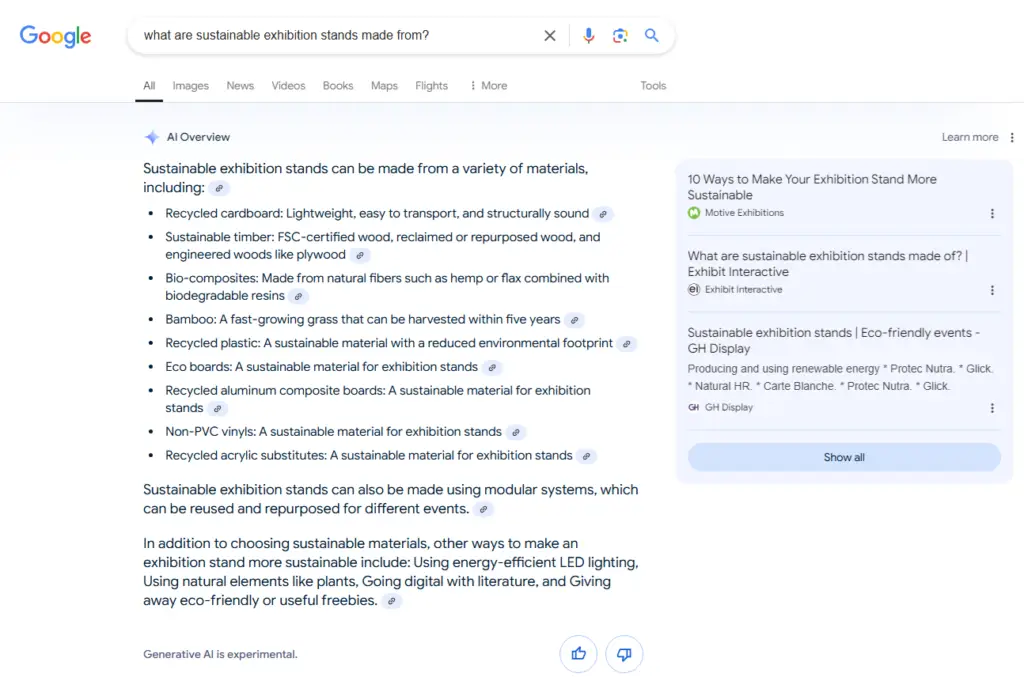Google recently introduced a new search feature in the UK: AI Overviews.
You may have already noticed them – they’re the AI-generated summaries that have started to appear at the top of search results for certain queries.
As a business owner, marketer or content creator, you need to understand AI Overviews. They can significantly impact your online visibility and traffic.
Google launched AI Overviews in the UK in August, and they’ve already started to have a significant impact on search results. According to independent research by Authoritas, AI Overviews are now being served up for 17% of all search queries in the UK and US.
AI Overviews – an evolution of Google’s Search Generative Experience (SGE), which launched last year – represent a significant shift in how Google presents its search results. They provide users with quick, comprehensive answers without the need to click through to multiple websites.
For your business, it means adapting your content strategy to ensure you’re not left behind.
This blog explains what AI Overviews are, how they work and how you can optimise your content to benefit from them. We’ll take a closer look at their mechanics, benefits and challenges, and share some practical strategies you can implement to make the most of this essential new feature. We hope that by the end of this article, you’ll have a clear understanding of how AI Overviews work and how you can adapt your content to thrive in this evolving digital landscape.
Understanding AI Overviews
AI Overviews are brief, AI-generated summaries that appear in Google Search results.
They aim to provide users with quick, comprehensive answers to their queries. They show up when Google’s systems think an AI-generated response would be beneficial. You’ll often see them for queries that require multiple searches to answer fully.
When you search for something like ‘how to find a holiday rental?’, you might see an AI Overview at the top of the results. It will summarise key points from various credible sources that Google has already ranked. The overview will also include links to these sources for more detailed information.
Here’s a real-world example featuring our client, Exhibit Interactive, a creative events design agency:

This example is featured in AI Overviews because it targets a long-tail keyword – that is, a question about a topic that people are searching for. In this case, the topic is sustainable exhibition stands and the long-tail keyword is ‘What are sustainable exhibition stands made from?’.
The information generated for the AI Overview is based partly on what’s included in the blog, which also features as the number one organic search result for that keyword.
The client has invested heavily in ongoing, expert-led SEO content and building backlinks. As a result, we’ve built the site’s domain authority and trustworthiness over time – key indicators that Google uses to decide how credible a website is. It means that Exhibit Interactive now features in several AI Overviews related to the content in its blogs and on its website. They’re not the only client we’ve achieved this for, either!
How AI Overviews work
Google uses advanced AI technology to create these overviews. It analyses information from multiple web sources and Google’s Knowledge Graph. It then generates a concise summary that answers the user’s query.
AI Overviews differ from featured snippets in a few key ways. Featured snippets directly quote a single source. AI Overviews, on the other hand, synthesise information from multiple sources. They provide a more comprehensive answer.
Also, AI Overviews use generative AI to create new text. They don’t just extract existing content. There’s a pro and a big con to this. While AI Overviews can provide the user with a more detailed answer to their search query based on information from a variety of sources rather than a single web page or blog, it can also generate incorrect or misleading information if the sources it draws from aren’t 100% accurate or legit.
However, we expect that as things progress, Google’s algorithm will get much better at filtering out low-quality or inaccurate sources and improving the quality of the AI Overviews it generates.
Benefits of AI Overviews
For users, AI Overviews offer quick access to information. They save time by providing a comprehensive answer without needing to visit multiple websites.
As a business owner or content creator, you can benefit from increased visibility if your content is featured in an AI Overview. Your website could be listed as a source, potentially driving more traffic to your site. However, it’s worth noting that AI Overviews might also lead to more ‘zero-click’ searches. Users might get their answers directly from the search results without clicking through to any websites.
That said, being featured in AI Overviews can also lead to more qualified traffic. Users who click through to your site from an AI Overview are more likely to be interested in your content, as they’ve already seen a summary and want more detailed information. This can result in lower bounce rates and higher engagement on your site.
AI Overviews can also help you reach a wider audience. Your content might be featured for queries you hadn’t specifically optimised for, exposing your site to new potential customers.
And for businesses with physical locations, being featured in AI Overviews for local searches can significantly boost your local SEO efforts. It can lead to increased foot traffic and local customer engagement.
It’s also worth noting that although SGE’s initial intention was to provide AI summaries for only informational searches, AI Overviews are also answering more commercial ‘buying’ questions and listing places you can buy products from. It’s too early to assess the impact of this, and it’s likely to evolve over time.
Understanding and leveraging AI Overviews can help you adapt your content strategy to maximise these benefits. The key is to focus on creating high-quality, compelling, in-depth content that encourages users to seek more information on your site and engage further with your brand.

Optimising your content for AI Overviews
Your content should provide clear, accurate answers to common questions in your niche to increase your chances of being featured in AI Overviews. So, implement strong on-page SEO practices, such as using relevant keywords, making the content as specific and in-depth as possible, and creating detailed meta titles and descriptions.
In the Exhibit Interactive example we showed earlier, the blog title was based on keyword research around a key aspect of the client’s business – sustainable exhibition stands. We wrote the article based on a long-tail keyword about sustainable exhibition stand materials, which answered the question specifically, which is why Google ranked the blog.
So, follow that lead by creating content that answers your customers’ most common queries. Think about the questions your target audience might ask and provide in-depth, detailed answers.
Google says that its ‘… systems automatically determine which links appear’ in AI Overviews.
It says ‘…there’s nothing special for creators to do to be considered other than to follow our regular guidance for appearing in search, as covered in Google Search Essentials”.
That’s an excellent tip.
Google Search Essentials is a fantastic free resource that anyone can access. It explains how Google reviews, ranks or rejects content. Following its guidelines will put your business in good stead. Get the SEO basics right, and you won’t go far wrong.
A logically structured user experience can also help Google understand your content better. Use appropriate schema markup to highlight essential information on your pages. Ensure your site is easily crawlable and indexable by Google. Check your robots.txt file and make sure it’s not blocking important pages.
Finally, mobile-friendliness and page speed are also crucial. Google prioritises mobile-friendly sites in its search results. Fast-loading pages provide a better user experience and are more likely to be featured in AI Overviews.
You can use Google Search Console to monitor your website’s performance in search results. Look for changes in your clickthrough rates and impressions that might indicate your content is being featured in overviews.

Potential challenges and how to address them
One potential challenge of AI Overviews is decreased clickthrough rates for some queries. If users get their answers directly from the overview, they might not visit your site. To address this, focus on creating content that goes beyond basic information. Offer unique insights or in-depth analysis that encourages users to click through for more details.
You might need to adapt your content strategy to succeed with AI Overviews or create more comprehensive, authoritative content that answers complex queries. It might also involve structuring your content in a way that’s easy for Google’s systems to understand and summarise.
The increased competition for visibility is another challenge. As more businesses optimise for AI Overviews, standing out becomes harder. To overcome this, focus on niche topics within your industry where you can provide expert insights. Develop a unique brand voice that shines through, even in summarised form.
There’s also the risk of misrepresentation. If AI Overviews summarise your content incorrectly, it could lead to misconceptions about your brand or offering. So, regularly monitor how your content appears in these overviews and be prepared to update it if necessary.
Google’s algorithms are constantly improving, which means the criteria for appearing in AI Overviews may change. So, stay informed about these updates and be prepared to adjust your strategy quickly.
But remember what we said earlier and follow Google’s guidelines. While search evolves, the principles of good SEO rarely change, so make sure you get the SEO basics right.
Maintaining a balance between optimising for AI and creating engaging, human-friendly content can be challenging. While structuring your content for AI understanding is vital, don’t sacrifice readability and user experience. Google prioritises websites which offer helpful, reliable, people-first content, so that should always be your goal, whatever you write.
Google plans to expand AI Overviews to more users and languages worldwide. It’s also not the only platform to use AI to provide generative search results. OpenAI’s ChatGPT-driven searchGPT and Bing Chat offer viable alternatives to AI Overviews, while Google is building Gemini, its own AI chatbot, into its own-brand mobile devices. These developments – and more – mean that this whole new sector of AI-driven search is set to grow massively in the months ahead. As it becomes more prevalent, it’s likely to have an even more significant impact on SEO and content creation.
Anticipating these challenges and proactively addressing them can turn them into opportunities for growth and increased visibility in the AI-driven search landscape.
How can QBD help?
AI Overviews represent a considerable shift in how Google presents its search results. They offer both opportunities and challenges for your business.
Focusing on creating high-quality, informative content and optimising your site for AI understanding can increase your chances of being featured in AI Overviews.
That’s where QBD can help.
We’ve already had massive success in helping a wide range of clients across various sectors to rank higher in Google search and feature in AI Overviews with high-quality, well-optimised creative content.
We can do the same for you.
Contact us today for a free, no-obligation conversation to discuss your SEO and digital content and see how we can help your business reap the rewards of Google’s new AI Overviews feature.

About the author
Jon is our Head of Creative Content. He works with a range of QBD clients, producing engaging, SEO-friendly website and digital content to help them reach a wider audience.
He does this by gaining a deep understanding of who our clients are, what they do, who their customers are and what makes them special, then helps them to tell their brand story in a way that connects with their target audiences.

